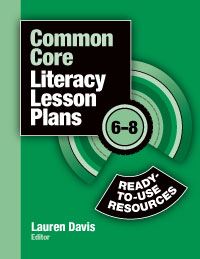A Major CCSS Resource
Common Core Literacy Lesson Plans: Ready-to-Use Resources, 6-8
By Lauren Davis
(Eye on Education/Routledge, 2013 – Learn more)
When I first received Common Core Literacy Lesson Plans, by Eye on Education editor (and former ELA teacher) Lauren Davis, I had mixed feelings.
I was afraid this would be one of the many books out there that promises to make life easy for middle school teachers with one-size-fits-all lesson plans. I have shelves full of teaching resource books that sounded great but once I got past the first few pages, I regretted that I had already highlighted sections and wouldn’t be able to return it.
This is not that kind of book. This is a resource you will consult again and again, and you may have a difficult time locating it because other teachers will be asking to borrow it.
Valuable for all content-area teachers

The publisher’s summary of the book’s features emphasizes the applicability of the lesson plans in subjects other than English/Language Arts, where the Common Core standards are raising the stakes for content-area literacy and students’ ability to read and write in nonfiction contexts.
“Middle school students,” the summary notes, “learn how to answer text-based questions, read informational texts, conduct research, write arguments, and improve their speaking and listening skills.”
All lessons are well researched and contain differentiation strategies that are applicable and attainable. In addition, the lesson plans include the following valuable information:
- Grade level suitability
- Time frame to complete the lesson and extension ideas
- General information about the goal and focus of the lesson and how to adapt it for other grade levels
- Common Core State Standards
- Student objectives
- Background knowledge students need to successfully implement the lesson
- Materials needed
- Step by step directions
- Differentiation
- Assessment ideas, rubrics and scoring guides
- A note-taking section that encourages reflection of what worked and what to change the next time the lesson is used
I shouldn’t admit it, but I usually jump right into the “meat” of lesson plan type books and skip the overview. I am so glad that I didn’t this time. In the overview, Davis reassures the teacher that adapting to the Common Core doesn’t mean you have to throw the baby out with the bath water.
Many teachers are afraid that the Common Core State Standards are going to eliminate teacher input and do away with past teaching practices and carefully wrought lesson plans. Davis explains that you can use lessons that you taught before, but cautions the reader to review the lessons to make sure they are complex enough and match the rigor the standards now require. Most important: look at your current teaching practices. For example, you may have to eliminate the “cute” haiku lesson that you’ve always done in the early grades — or rethink the Romeo and Juliet unit in middle school. However, I believe you will become reinvigorated as you reflect on best practices in teaching and think about ways you can adapt these lessons to challenge your students to meet the new standards.
A thoroughly professional book
This is a thorough book that combines research, lesson planning, and resources in a highly professional manner. While so many “test prep books” or genre specific books focus solely on step-by-step lessons, this is not the case with Common Core Literacy Lesson Plans. This is not about teaching by formula. An added bonus and valuable piece to this book is the section labeled “Additional Resources,” which provides links to exemplars, sources for extension practice, and websites that address the application of the Common Core Standards. You can also access the handouts described in the book by registering your buyer’s access code online.
As I previewed some of the book’s content, I realized that the lessons were formatted according to the Readers and Writers Workshop, a best-practice model where instruction is offered through the workshop approach — enabling students to work independently, via a gradual release of responsibility from teacher modeling to student directed work.
While I skimmed through the lessons, I was amazed by the number of practical ideas that were provided to encourage active student interaction. One example, in the Speaking and Listening Skills section, suggests that you map students’ taking turns talking so that you can identify patterns. Students sit in a circle during a discussion and you draw the seating pattern on a piece of paper, then draw arrows on the circle and take notes to keep track of who is responding to whom. Another idea: making video recordings of class discussions so students can view and reflect upon their own speaking and listening habits. So uncomplicated, yet so complex.
As a reviewer, I could not find anything to criticize in the book. As a perpetual teacher-learner, I wanted to visit all the resource sites that were included — but that’s my problem! I am excited about sharing this book with my colleagues as we continue to pursue the Common Core Standards.
(Editor’s note: Common Core Literacy Lesson Plans is also available in a K-5 and a 9-12 edition.)
Linda Biondi is a fifth grade teacher at Pond Road Middle School in Robbinsville, New Jersey. She has written for Education World, the Responsive Classroom newsletter, and the ERIC Clearinghouse. She’s also the recipient of several grants that promote inquiry and a literacy enriched curriculum, and consults for the National Writing Project.


































